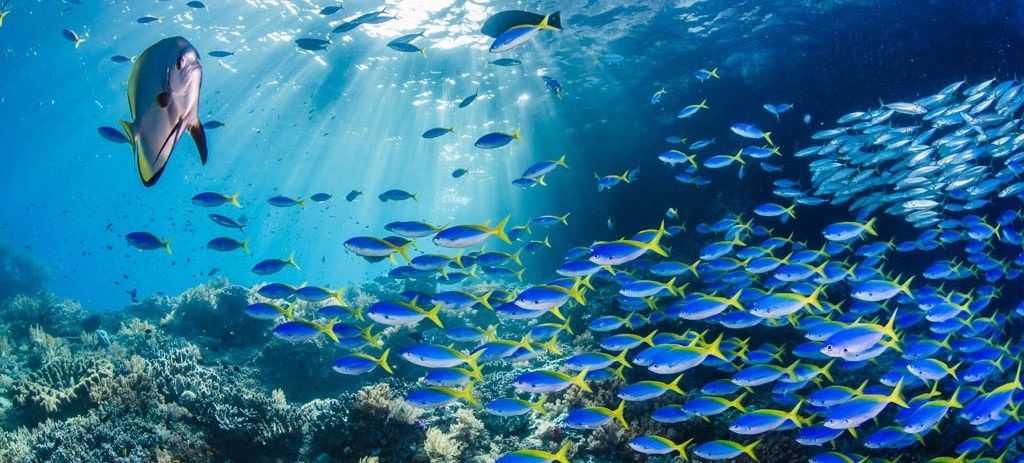





Disclaimer: Copyright infringement not intended.
Context
The new Study
Findings
Implications
Suggestions made
Marine Protected Areas
Types of MPAs:
Goals and Objectives:
Benefits of MPAs:
|
Why are MPAs crucial? Marine Protected Areas (MPAs) serve a crucial role in conserving marine biodiversity, regulating fishing practices, mitigating climate change, promoting research and education, and providing economic benefits. These areas help preserve the diverse array of marine species and their habitats, thereby maintaining the delicate balance of marine ecosystems. They regulate fishing activities to prevent overfishing, thus supporting sustainable fishing practices. Additionally, MPAs act as carbon sinks, absorbing and storing carbon dioxide from the atmosphere and mitigating the impacts of climate change on marine ecosystems. They provide opportunities for scientific research and education, increasing our understanding of the marine environment and promoting ocean literacy. Further, they contribute to local economies through sustainable tourism, recreation, and supporting local fishing communities. |
Challenges and Considerations:
Global Initiatives:
Examples of Notable MPAs:
Marine Protected Areas in Antarctica
Background
Importance of Antarctic Marine Environment:
CCAMLR (Commission for the Conservation of Antarctic Marine Living Resources):
Antarctic MPA Developments:
Ross Sea MPA:
East Antarctica:
Establishment Challenges:
Scientific Research:
Future Prospects:
Ongoing Negotiations:
Climate Change Concerns:
International Collaboration:
Balancing Conservation and Sustainable Use:
India will continue to support setting up two MPAs in Antarctica to protect marine life and its ecosystem services
Conclusion:
|
Marine Protected Areas (MPAs) in India Marine Protected Areas (MPAs) in India are made up of 33 national parks and wildlife sanctuaries designated under the Wildlife (Protection) Act of 1972. There are 31 MPAs in India, with the Marine National Park and Marine Sanctuary in the Gulf of Kutch and Bhitarkanika National Park and Bhitarkanika Sanctuary making up one unit each. MPAs occupy less than 4.01% of the total area of all Protected Areas in India. |
Commission for the Conservation of Antarctic Marine Living Resources
Establishment and Legal Framework:
Member Countries:
Key Objectives:
Conservation Measures:
Ross Sea MPA:
Decision-Making Process:
Challenges and Future Directions:
International Cooperation:
|
PRACTICE QUESTION Question: Consider the following statements regarding Marine Protected Areas (MPAs):
Which of the statements above is/are correct? A) 1 only Answer: C) 1 and 3 only Explanation:
Therefore, the correct answer is C) 1 and 3 only. PRACTICE QUESTION Q. Marine Protected Areas (MPAs) have emerged as key tools for the conservation and sustainable management of marine ecosystems. Discuss the significance of MPAs in the context of biodiversity conservation, fisheries management, and their role in addressing global environmental challenges. Analyze the challenges faced in the establishment and effective management of MPAs and suggest measures to overcome these challenges. Illustrate your answer with relevant examples from around the world. Model Answer Marine Protected Areas (MPAs) are designated regions in oceans, seas, or other bodies of water where human activities are regulated to conserve and protect the marine environment and its biodiversity. The primary goal of establishing MPAs is to safeguard ecosystems, preserve marine species, and promote sustainable use of marine resources. Significance of MPAs:
Challenges in Establishment and Management:
Measures to Overcome Challenges:
Illustrative Examples:
In conclusion, MPAs are critical tools for addressing marine conservation challenges, and their effective establishment requires a holistic approach involving science, technology, community engagement, and international collaboration. Learning from successful examples and adapting strategies to diverse contexts can enhance the global impact of MPAs in sustaining marine ecosystems. PRACTICE QUESTION Question: Which of the following is the largest Marine Protected Area (MPA) established to date? A) Galápagos Marine Reserve B) Papahānaumokuākea Marine National Monument C) Great Barrier Reef Marine Park D) Ross Sea Marine Protected Area Answer: B) Papahānaumokuākea Marine National Monument Explanation: Papahānaumokuākea Marine National Monument, located in the Northwestern Hawaiian Islands, is the largest Marine Protected Area (MPA) established to date.
The other options are also significant MPAs, but they are not the largest:
Therefore, the correct answer is B) Papahānaumokuākea Marine National Monument. PRACTICE QUESTION Question: Which international organization is responsible for the conservation and sustainable management of marine living resources in the Southern Ocean, including the establishment of Marine Protected Areas (MPAs)? A) United Nations Environment Programme (UNEP) B) International Maritime Organization (IMO) C) Commission for the Conservation of Antarctic Marine Living Resources (CCAMLR) D) Convention on Biological Diversity (CBD) Answer: C) Commission for the Conservation of Antarctic Marine Living Resources (CCAMLR) Explanation: The Commission for the Conservation of Antarctic Marine Living Resources (CCAMLR) is the international organization responsible for the conservation and sustainable management of marine living resources in the Southern Ocean, including the establishment of Marine Protected Areas (MPAs).
The other options are different international organizations with distinct roles:
Therefore, the correct answer is C) Commission for the Conservation of Antarctic Marine Living Resources (CCAMLR). |







© 2025 iasgyan. All right reserved